

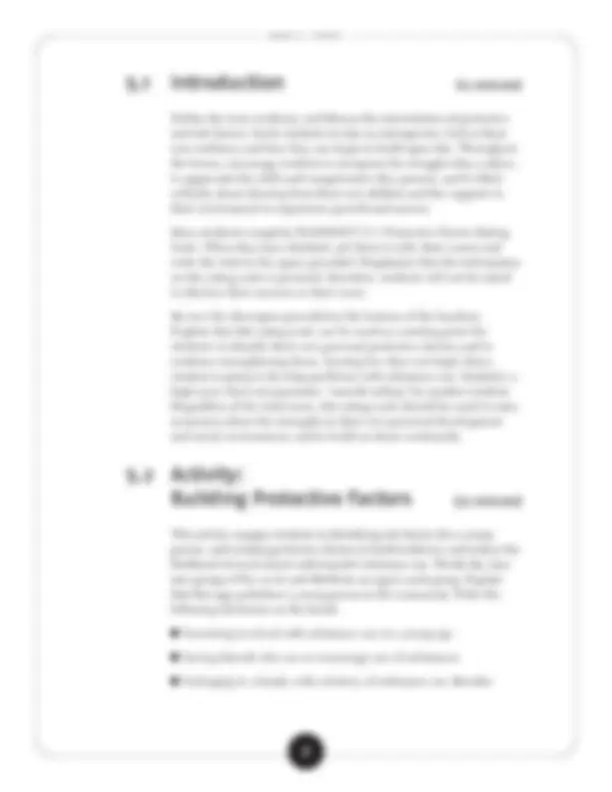
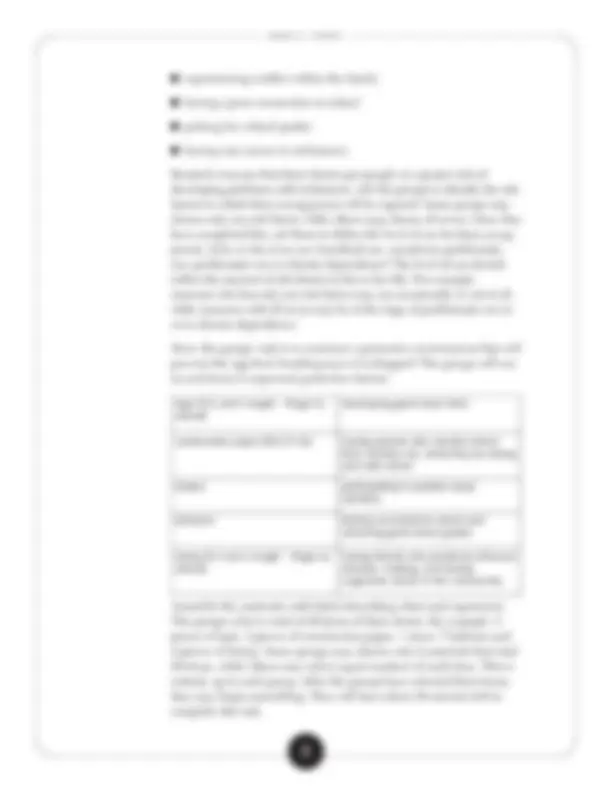
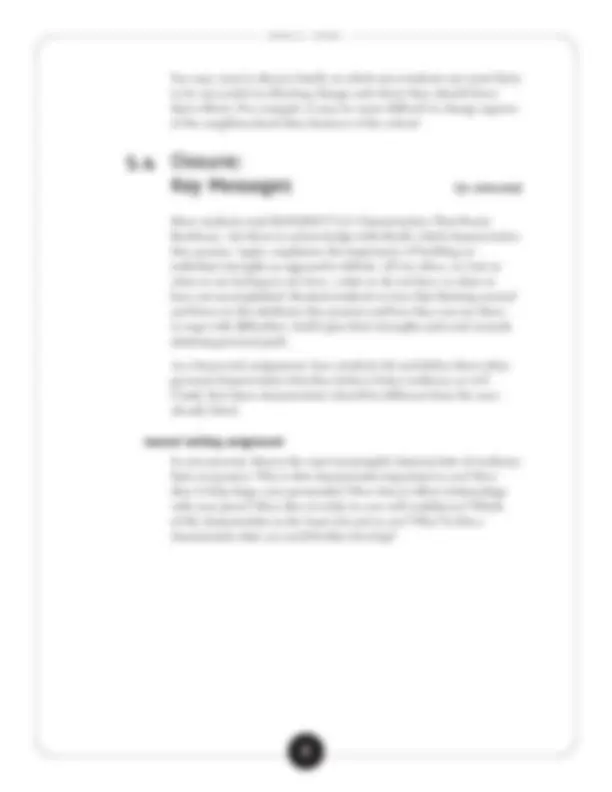
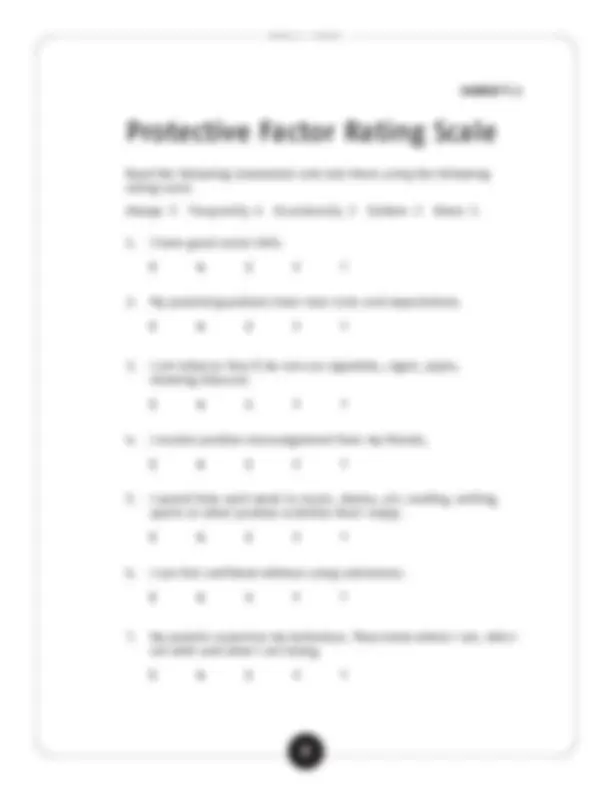
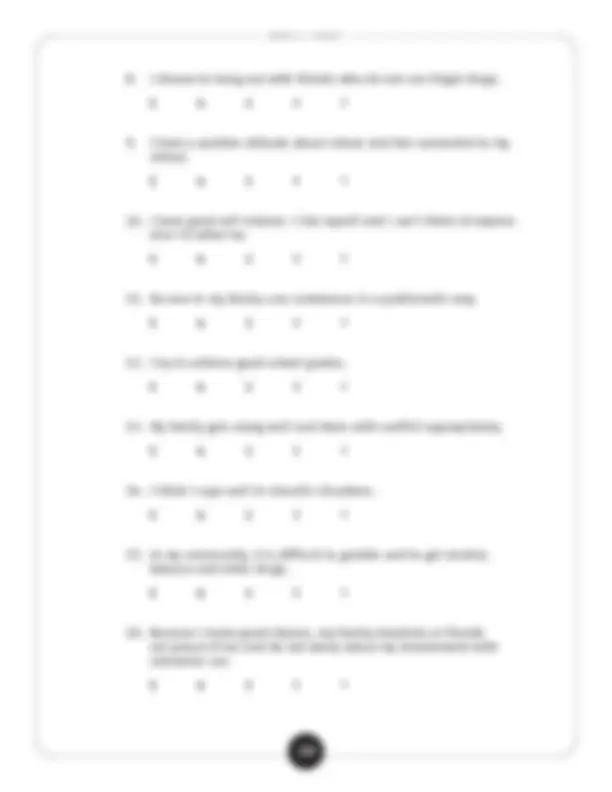


Study with the several resources on Docsity

Earn points by helping other students or get them with a premium plan


Prepare for your exams
Study with the several resources on Docsity

Earn points to download
Earn points by helping other students or get them with a premium plan
Community
Ask the community for help and clear up your study doubts
Discover the best universities in your country according to Docsity users
Free resources
Download our free guides on studying techniques, anxiety management strategies, and thesis advice from Docsity tutors
A Grade 11 lesson plan on resiliency, focusing on understanding the concept, recognizing interrelatedness of protective and risk factors, assessing personal protective factors, and acknowledging characteristics of resiliency. Students engage in activities to build protective factors and decrease risk factors, using materials like handouts and props.
Typology: Exams
1 / 12

This page cannot be seen from the preview
Don't miss anything!







659E-V3 (December 2019)ProvincialAddictionPrevention,Addiction&MentalHealth
LESSON OBJECTIVES
Eggs, tape, construction paper, straws, balloons, string and newspaper TEACHER-MADE SIGNS:
Resiliency has been defined as “the ability to thrive, mature, and increase competence in the face of adverse circumstances.” (Gordon, 1995). Some people are amazingly resilient: they survive torture, traumatic childhood, even time in a concentration camp, and actually grow through their experiences. But all of us have some resiliency. It has been found that one-half to two-thirds of children who grow up in families with mental illness, alcohol use disorder, abuse, or criminally involved parents or in poverty-stricken or war-torn communities overcome adversity and become successful adults. (Benard, 1995, p. 1). For people to overcome trouble, somehow the protective factors in their lives have to outweigh the forces that drag them down. Some of these protective factors are present in resilient people themselves, characteristics like insight, independence, initiative, creativity, a strong ethical sense, and the ability to see the funny side of difficult situations. Other protective factors come from their environment. Youth can decrease their chances of problems like dropping out of school, coming into conflict with the law, or being harmfully involved with substance use by increasing the protective factors in their lives. The aspects of life that increase their chances of these and other problems are called risk factors. Protective and risk factors can be categorized into the five main areas: the individual, family, school, peers and neighbourhood (AADAC, 2003d, p. 3). Protective factors include the following: developing good social skills (the individual) having parents who monitor where their children are, what they are doing and with whom (family) participating in positive social activities (neighbourhood) feeling connected to school (school) achieving good school grades (school) having friends who positively influence decision-making (peers) having supportive adults in the community (neighbourhood) (AADAC, 2003e, p. 26)
5.1 Introduction (15 minutes) Define the term resiliency and discuss the interrelation of protective and risk factors. Invite students to take an introspective look at their own resiliency and how they can begin to build upon this. Throughout the lesson, encourage students to recognize the struggles they endure, to appreciate the skills and competencies they possess, and to think critically about drawing from their own abilities and the supports in their environment to experience growth and success. Have students complete HANDOUT 5.1: Protective Factor Rating Scale. When they have finished, ask them to tally their scores and write the total in the space provided. Emphasize that the information on the rating scale is personal; therefore, students will not be asked to disclose their answers or their score. Review the descriptor provided at the bottom of the handout. Explain that this rating scale can be used as a starting point for students to identify their own personal protective factors and to continue strengthening these. Scoring low does not imply that a student is going to develop problems with substance use. Similarly, a high score does not guarantee “smooth sailing” for another student. Regardless of the total score, this rating scale should be used to raise awareness about the strengths in their own personal development and social environment, and to build on these continually. 5.2 Activity: Building Protective Factors (35 minutes) This activity engages students in identifying risk factors for a young person, and creating protective factors to build resiliency and reduce the likelihood of involvement with harmful substance use. Divide the class into groups of five or six and distribute an egg to each group. Explain that this egg symbolizes a young person in the community. Write the following risk factors on the board: becoming involved with substance use at a young age having friends who use or encourage use of substances belonging to a family with a history of substance use disorder
experiencing conflict within the family having a poor connection to school getting low school grades having easy access to substances. Remind everyone that these factors put people at a greater risk of developing problems with substances. Ask the groups to identify the risk factors to which their young person will be exposed. Some groups may choose only one risk factor, while others may choose all seven. Once they have completed this, ask them to define the level of use for their young person. Is he or she at no use, beneficial use, casual/non-problematic use, problematic use or chronic dependence? The level of use should reflect the amount of risk factors in his or her life. For example, someone who has only one risk factor may use occasionally or not at all, while someone with all seven may be at the stage of problematic use or even chronic dependence. Next, the groups’ task is to construct a protective environment that will prevent the egg from breaking once it is dropped. The groups will use several items to represent protective factors: tape (1/2 arm’s length - finger to elbow): developing good social skills construction paper (81/2 X 11): having parents who monitor where their children are, what they are doing and with whom straws: participating in positive social activities balloons: feeling connected to school and achieving good school grades string (1/2 arm’s length - finger to elbow): having friends who positively influence decision-making, and having supportive adults in the community Assemble the materials with labels describing what each represents. The groups select a total of 20 items of their choice (for example, 5 pieces of tape, 3 pieces of construction paper, 1 straw, 7 balloons and 4 pieces of string). Some groups may choose only 2 materials that total 20 items, while others may select equal numbers of each item. This is entirely up to each group. After the groups have selected their items, they may begin assembling. They will have about 30 minutes left to complete this task.
In answering the last question, you may want to group student answers into the five main areas: the individual, family, school, peers and neighbourhood (AADAC, 2003d, p. 3). Here are some examples
physical trauma or abuse (the individual) poor self-concept (the individual) early aggressive behaviour (the individual) weak attachment to parents/guardians (family) parents/guardians with unclear rules and expectations (family) parents/guardians who have permissive attitudes about substance use (family) friends with favourable attitudes about substance use (peers) friends who perceive use as the norm (peers) lack of commitment to school (school) dropping out of school (school) community laws and norms that promote use of substances (neighbourhood)
ability to cope with stress (the individual) strong self-esteem (the individual) independence and initiative (the individual) positive attachment to parents/guardians (family) parents/guardians with clear rules and expectations (family) minimal family conflict (family) positive relationships with friends (peers) friends who are not involved with substance use (peers) participation in extra-curricular activities at school (school) high expectations about school grades (school) positive activities in the community (neighbourhood) (AADAC, 2003d, p. 12-23)
You may want to discuss briefly in which area students are most likely to be successful in effecting change and where they should focus their efforts. For example, it may be more difficult to change aspects of the neighbourhood than features of the school. 5.4 Closure: Key Messages (10 minutes) Have students read HANDOUT 5.2: Characteristics That Foster Resiliency. Ask them to acknowledge individually which characteristics they possess. Again, emphasize the importance of building on individual strengths as opposed to deficits. All too often, we look at what we are lacking in our lives—what we do not have or what we have not accomplished. Remind students to turn that thinking around and focus on the attributes they possess and how they can use these to cope with difficulties, build upon their strengths and work towards attaining personal goals. As a homework assignment, have students list and define three other personal characteristics that they believe foster resiliency as well. Clarify that these characteristics should be different from the ones already listed. Journal writing assignment In your journal, discuss the most meaningful characteristic of resiliency that you possess. Why is this characteristic important to you? How does it help shape your personality? How does it affect relationships with your peers? How does it relate to your self-confidence? Which of the characteristics is the least relevant to you? Why? Is this a characteristic that you could further develop?